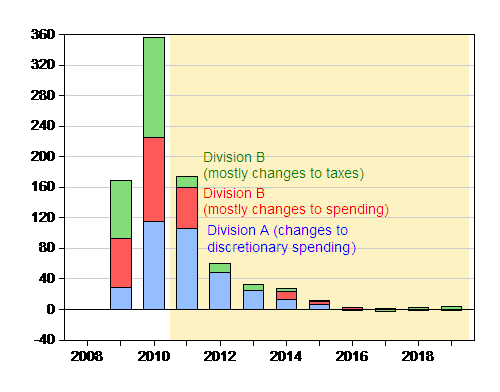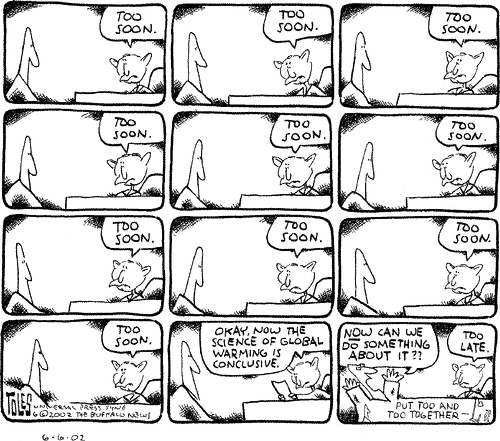The CBO has posted an actual “cost estimate” on HR 1 (not just a partial examination of Division A, as explained in the Director’s Blog, the locus of great disinformation in previous discussions, as recounted by Dean Baker). Here is a graphical depiction of what CBO believes will be the impact on the deficit (once again, recalling that there is an explicit omission of repercussion effects on tax revenues and transfers that would arise from elevated aggregate demand; in other words, this is the estimated impact on the full employment budget balance).

Figure 1: Estimated spending and tax revenue reductions, per fiscal year, embodied in HR 1. Shaded areas pertain to spending occurring outside of the 20 month time frame. Source: CBO, Cost Estimate of HR 1 (January 27, 2009).
The breakdown of appropriations and estimated spending is to be found in the last pages of this report.
I notice that some people are arguing that some of the spending is taking place outside of the time frame that is relevant. I refer such individuals to the CBO’s estimate of the output gap, discussed in this post; note how persistent the negative output gap is. Thinking back to how some of these same individuals argued against further stimulus a few months back, because it was too early to tell whether the first stimulus package from January 2008 had worked, I am reminded of this graphic (albeit applied to a different context).

I don’t understand the basic premise, other than this typical keynesian crutch of rationale for the stimulus.
why aren’t any economists arguing for better trade policy w/ china, a higher valued yuan, and a large increase in exports for US, such that it could finance an increase in personal savings?
why issue more debt to spend more money, that the country doesn’t have on a collective basis (public+private debt all considered in)?
it’s just moronic and can only be justified with stupid economic models, that simultaneously ignore the basics of finance — what is an ROI positive decision.
1. China determines the value of the yuan.
2. A large increase in exports for a country with no manufacturing base left is unrealistic in the short term
3. China owns a huge amount of our debt. If we try to punish them with Smoot-Hawley II, they dump it. Without cheap credit to finance our government, we either raise taxes, cut spending, or politely ask several million Americans to stop existing.
1. I’m not sure what transnationals are doing currently, but they used to partner with China in order to facilitate their Chinese exports sales to the US and Europe, yes? IOW the fx was dominated by the large transnationals in the pretty recent past.
2. I’m not sure that manufacturing capacity in the US could not B de-mothballed or refreshed…given the new dire straight-like conditions. But where are the consumers?
3. China is not likely too happy at the prospect of seeing their stash of tbills melt (visit the recent auction to see that CBs are still buyin) but agency debt might be another story. (Fannie’s latest dip into the Asset Bag not a good sign.) Japan (and Middle East Oil?) also owns a whack of tbills so there are plenty of interested parties in respectable tbills. The kindness of strangers persists…so far.
Menzie writes: “ Thinking back to how some of these same individuals argued against further stimulus a few months back, because it was too early to tell whether the first stimulus package from January 2008 had worked,” And I am stunned by the entire horde that views this action (government spending on job creation programs, health programs and the despicable like! Who is going to pay for that!!!) in such a different light than the $300B Salvation so far to Citi…for our rescue from “total systemic collapse”. Just because they have been proven wrong in this one incident, this financial soft spot, doesn’t mean that their entire careers have been misspent in the wrong school. No, they could be right tomorrow…their job security depends on it…and that growing throng of unemployed young people whose hopes and aspirations have been trashed, well, the fittest will survive and the civil unrest managed…such is the extent of their denial…and why some Keynesians view their mistaken views as dangerous…as political liabilities.
1: We know. I assume prophets is suggesting that economists promote policies that would encourage China to float the yuan
2: Your being a bit hyperbolic. Im sure we can find some factories here with excess capacity.
3: When economists suggest a “better trade policy”, I dont think they are not refering to something like Smoot-Hawley.
Menzie,
If you are looking for future article ideas, I would be curious on your thoughts about the effectivness of where the money gets spent (I think we can assume the bill will pass). For example, will a 50 million grant to the National Endowment for the Arts to employ artists have the same macroeconomic effects as a $50 infrastructure project? Sorry if I have missed this in a previous post.
prophets, you seriously think exports are going to bring us out of a recession? who exactly is going to be buying all our goods again? hmm, perhaps china would, since they doing a fiscal stimulus… tho wouldn’t it be better if we bought our own goods?
You gentlemen are all being disingenuous.
There is certainly a case to be made that the cure to what ails the US is a good dose of austerity. Americans need to work harder, produce more, save more, and consume less. We need to rebuild ballance sheets across the economy.
The US is still the largest manufacturer in the world. A properly valued yen and yuan would go a long way towards fixing at least some of our problems.
Going along with the austerity idea, LESS SPENDING and HIGHER TAXES would be the order of the day. Deleverage the Federal Government’s ballance sheet, if you will. I’m too much of a supply sider to take this to its logical end, but aren’t there any Bob Rubin devotees left out there?
Or… how about letting the Federal Reserve do its job, and don’t ram through a pork laden “stimulus” package that is anything but.
Menzie’s boot licking in the post is very unfortunate. I was looking forward to a condemnation of at least the useless demand side tax cuts. Can’t we get some consistancy here?
And would it be the worst thing in the world, if we want to use “stimulus” in the proper sense of the word, to do a series of small stimuluses? Clearly the stimulus last year had an impact for a short while (Q2 wasn’t bad, right?). Then, when things pick up, the stimulus could be more easily removed.
This package as proposed is a monster, and has more to do with rewarding Democrat constituancies than stimulating the economy.
It won’t work it didn’t in the thirtys and the stimulus won’t work today First off they aren’t supposed to create jobs for the people Their job is to stay out of peoples buissness that know how to create jobs 1)no income tax at all 2)no federal reserve What about this a pay scale for all elected officials to be within 90% of the average workers pay How about no borrowing from other governments and the U.S.Govt issuing their own money backed by something tangible like silver nah thats to smart